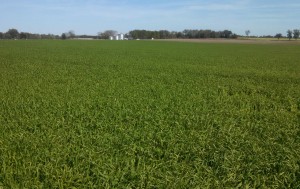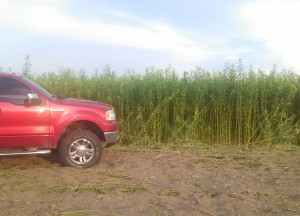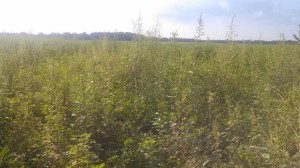We have been working with Sunn Hemp as a summer cover crop on a production scale for about 5 years now. This is a fast growing, nitrogen fixing legume that thrives in a warm climate. One local farmer plants a couple irrigated fields each year after the corn crop is harvested. These are fields that have two redeeming qualities: poor soils and a population of herbicide tolerant Palmer Amaranth (PA). Corn silage or grain is typically harvested from these fields in July or August. This schedule leaves about 100 or more days for PA to explode and create a wealthy seed bank. Most of those seeds result in another herbicide tolerant weed over the next 3 to 4 years.
In this part of the world, one “go-to” crop rotation is irrigated corn rotated annually with irrigated peanuts. The fallow period following corn, although good to rest the land, has resulted in populations of PA that are difficult to control. We have been very satisfied with the control of PA by Sunn Hemp when planted following corn harvest. In fact, we often see PA germinate, and the competition from Sunn Hemp results in completely choking out the PA.
We have watched this land building cover crop grow and so far haven’t observed any drawbacks for the succeeding peanut crop. However, I have hoped for the opportunity to gather additional value from the plowdown of the Sunn Hemp, which is a legume plant that is high in Nitrogen. It is also a good scavenger of residual potash that may be leached from the sandy soil during the rainy mnths of the summer. This year, I have the opportunity to observe a fall planted forage crop, a mix of small grains and ryegrass, growing behind the Sunn Hemp. While we won’t have any specific information beyond field average yield, it appears to me that we will have higher total production on this field compared to nearby fields where corn was grown last year without a Sunn Hemp cover crop.
Costs to plant the Sunn Hemp have averaged from $35-50 per acre. It is often difficult to convince yourself and others that the utility of a reduced weed bank has this return of value, when suitable chemical control still exists in the crops grown. However, if all other inputs are equal, a one ton increase in forage yield will have an economic value in excess of these costs. Positive economic return on investment within 9 months of planting a cover crop could create convincing argument. Therefore, we are watching closely to determine if a yield boost occurs. We have not looked at reduced fertilizer applications following the Sunn Hemp, but should obviously consider that. The USDA reports potential production of 100-140 pounds of nitrogen per acre by the legume.
This forage crop will be harvested in late March to April, which offers excellent timing to get the peanut crop planted. We don’t have conclusive data or replicated comparisons, but have been satisfied in all situations over the last several years where peanuts were grown the year following a Sunn Hemp cover crop. I hope we can continue to develop and improve crop rotations that will harness the benefits offered by summer grown cover crops.

Winter forage crop growing following plowdown Sunn Hemp cover crop. Additional fertilizer was also applied at recommended rates.
Additional information about Sunn Hemp:



mace,
had similar results with sun hemp blended with some leftover sesame, iron clay peas, soybeans, sorghum sudan, buckwheat and grains sorghum planted behind sweet corn in june 2013. the following oats, rye, ryegrass cover crop we notilled into that blend after rolling down grew off real well and had dark green color. some attached info on sun hemp:
http://edis.ifas.ufl.edu/ng043
http://www.nrcs.usda.gov/Internet/FSE_DOCUMENTS/nrcs142p2_053283.pdf